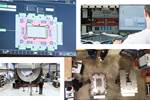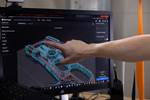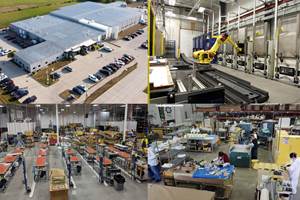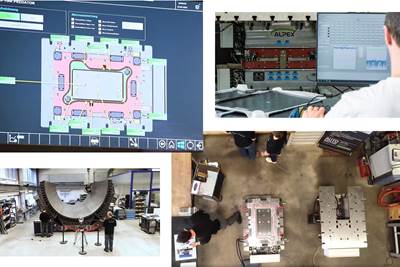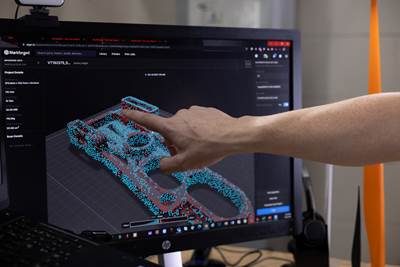Clemson Composites Center leads research in low-cost composite tooling
Innovative technology approach to use additive manufacturing and artificial intelligence to produce tools faster, at a lower cost and with less environmental impact.
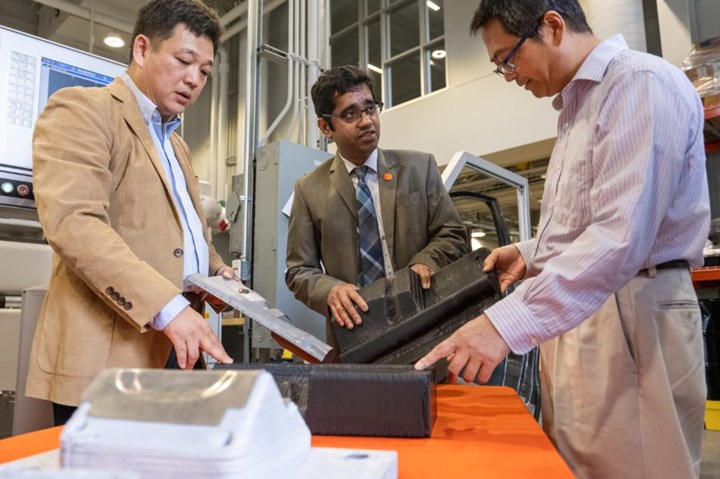
Srikanth Pilla (center) talks about manufacturing tools with Gang Li (left) and Feng Luo (right). Photo Credit: Clemson Composites Center
Clemson University’s (CCC, Greenville, S.C., U.S.) team is leading a new study — the development of new ways to 3D print low-cost manufacturing tools — that could help manufacturers save time and money while reducing their environmental impact.
The research, to be based at the CCC’s Greenville, S.C., facility, is funded with $5.16 million from the U.S. Department of Energy’s (DOE) Advanced Manufacturing Office and industry partners. Collaborators on the project include Ohio-based Honda Development & Manufacturing of America, Ohio State University (Athens) and Additive Engineering Solutions LLC (Akron).
Since its founding in 2017, the CCC has built its reputation for developing new ways of making ultralight and recyclable automotive components out of composite materials. The project will add to the center’s fast-growing portfolio of industry-guided automotive and advanced manufacturing research.
With the new funding, the center’s researchers are said to be using some of the same techniques to create not the components themselves but the tools that would be used to stamp sheets of metal or composites into components, says Srikanth Pilla, the project’s principal investigator, founding director of the CCC and the Jenkins Endowed Professor of Automotive Engineering. According to Pilla, the research could help lower the cost of tools, which are often expensive to develop and produce.
“The composite tool is a low-cost technology,” Pilla says. “At the same time, you can recycle the tools we will be creating. That’s why we decided to repurpose innovations that happened in the Clemson Composite Center for these kinds of applications.”
Researchers expect that at the end of the project they will have technology that OEMs could rapidly commercialize and put into use in a real-world factory.
A big part of what makes the research unique is that the team will be using innovative techniques, including artificial intelligence (AI), applied by Feng Luo, the Marvin J. Pinson, Jr. ’46 Distinguished Professor in Clemson’s School of Computing and founding director of the Clemson Artificial Intelligence Research Institute for Science and Engineering (AIRISE). Researchers will start with the desired performance of the tool they want to create, and AI will help determine the ideal composite material architecture and optimal manufacturing process, an approach called inverse design.
Gang Li, a Clemson mechanical engineering professor and CCC associate director, will use computational modeling and analysis simulation to help answer important questions, such as whether the tools researchers are trying to develop meet design requirements. The approach is said to enable researchers to test their ideas even before building a prototype, helping save time and money.
For Li, the project is an extension of his previous work with the CCC. He has also worked to help develop an ultra-lightweight vehicle door, advance 3D printing, modernize manufacturing machinery and reduce the weight of an SUV part that is interchangeably called the body-in-white or glider. “Our research is looking at the entire development and design of the vehicle, and that excites me a lot,” he says. “We’re not just looking at one small part, we’re looking at everything we can.”
The project is the CCC’s latest collaboration with Honda Development & Manufacturing of America. Both partners previously worked together on other projects, including the glider and the ultralight door, which recently was .
Ryan Hahnlen, a principal engineer at Honda Development & Manufacturing of America, says he looks forward to collaborating with the Clemson team again.
“This project brings new opportunities to develop new products for our customers more quickly and efficiently, while saving costs up and down the supply chain,” Hahnlen notes. “With this new research we will be better positioned to reduce carbon emissions and be more flexible to changing market conditions.”
The research is also the CCC’s latest collaboration with Ohio State University, led by Farhang Pourboghrat, professor and chair of the Integrated Systems Engineering Department. Andrew Bader, vice president and co-founder of Additive Engineering Solutions, expects to meet the project’s needs with the company’s experience in large-format additive manufacturing services for tooling, end-use parts and large-scale prototyping.
Related Content
Com&Sens presents workshop on fiber optic sensing for COPVs
Three-day hands-on workshop from June 11-13 in Leuven, Belgium, will equip participants with a better understanding of fiber optic sensing technology for digital manufacturing of composite tanks.
Read MorePlant tour: Sekisui Aerospace, Orange City, Iowa, Renton and Sumner, Wash., U.S.
Veteran composites sites use kaizen and innovation culture to expand thermoplastic serial production, 4.0 digitization and new technology for diversified new markets.
Read MoreWichita State, Dassault Systèmes open Manufacturing Innovation Center
Aviation companies of all sizes will be able to improve their resilience and efficiency via the center’s virtual design, automation and additive manufacturing capabilities.
Read MoreUniSQ, iLAuNCH Trailblazer program drive digital twin innovation for composite repairs
Working with Boeing Australia, Memko and Dassault Systèmes, the University of Southern Queensland (UniSQ) has developed a digital twin via the 3DEXPERIENCE platform, digitizing processes that could lead toward more efficient and effective maintenance, repair and operations of future fleets.
Read MoreRead Next
Digitizing tools for composites production
Alpex Technologies focuses on industrialization, process and part intelligence and biocomposites in its next generation of tooling systems.
Read MoreVestas implements composites 3D printing to increase efficiency for blade alignment tools
A Markforged digital repository and multi-material 3D printers enable faster, more accurate and less costly manufacture of a variety of tools and blade components across Vestas sites.
Read MoreCeramic matrix composites: Faster, cheaper, higher temperature
New players proliferate, increasing CMC materials and manufacturing capacity, novel processes and automation to meet demand for higher part volumes and performance.
Read More
